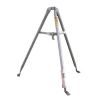Global Water WE900 Weather Station
The Global Water WE900 Weather Station is an easy-to-use and economical weather station for monitoring many weather conditions.
Features
- Easy-to-use and economical
- High quality, rugged, industrial grade sensors for monitoring, alarming, and reporting
- Electronics are fully encapsulated for complete protection and long operating life
- Free ground shipping
- Expedited repair and warranty service
- Lifetime technical support
- More
Overview
The Global Water WE900 Weather Station is an easy-to-use and economical weather station for monitoring many weather conditions. The weather station is designed to be a drop-in weather monitoring station for easy integration with existing systems. The weather station's 4-20mA sensors will interface with any SCADA, PLC, or RTU system that can accept a 4-20mA input.
Installation
Global Water's Weather Station includes full assembly on a sturdy and durable stainless steel tube frame that can be mounted onto a pre-existing base or onto the WE830 Global Water Tripod for proper installation. The unit is designed for durability and endurance in harsh conditions. The WE770 Solar Shield, a ventilated sun shield with high reflectiveness, low heat retention, and low thermoconductivity, is provided as protection and a mounting platform for the Temperature and Humidity sensors.
Includes the following weather sensors and installation hardware:
- WE550 Wind Speed Sensor
- WE570 Wind Direction Sensor
- WE700 Temperature Sensor
- WE600 Humidity Sensor
- Solar Radiation Shield
- WE820 Weather Station Mounting Frame
- Junction box
In The News
Floating Global New Ideas: Buoy-Enabled Research at Florida Agricultural and Mechanical University’s School of the Environment
Florida Agricultural and Mechanical University (FAMU), based in Tallahassee, Florida, is the highest-rated public Historically Black College or University in the United States. FAMU’s School of the Environment (FAMU-SOE) offers BS and BA degrees in Environmental Studies, and BS, MS, and Ph.D. degrees in Environmental Science, with specialisms available in areas including Environmental Policy and Risk Management, Aquatic and Terrestrial Ecology, and Biomolecular Sciences. In 2021, FAMU-SOE deployed a NexSens CB-450 buoy in Apalachee Bay, a key oyster farming area around 30 miles south of Tallahassee. The buoy has quickly been incorporated into the curriculum, providing environmental insights for student research, the community, and beyond. Dr.
Read MoreMonitoring Habitat Suitability and Water Quality in Northwest Arkansas Springs
Northwest Arkansas has seen an economic, industrial, and population boom in recent years as a result of expanding businesses, which have created thousands of jobs in the region and the mass migration of employees and construction companies. However, with this growth has come rapid urbanization and the degradation of the natural landscape, specifically the freshwater springs that can be found throughout the region. These springs are critical habitat centers for native wildlife, home to threatened and endangered fish, and those that have yet to be listed. Zach Moran, Assistant Professor of Fisheries Science at Arkansas Technical University, is working to help monitor these habitats and provide key data that will hopefully inform future development in the region.
Read MoreThree Decades of Research at Acton Lake
A multi-disciplinary team at Miami University, Ohio, has been studying the environmental change at Acton Lake for over three decades. Using three different NexSens buoys over this time, the team has an incredible archive of data that is helping build a picture of Acton’s past, present, and future. Until recently, a NexSens CB-50 buoy was used alongside other environmental monitoring at Acton Lake. In May 2025, the Miami team deployed a new XB-200 buoy , future-proofing their ongoing monitoring using real-time buoy systems. Acton Lake, a small hypereutrophic reservoir in southwest Ohio, covers 2.4km² and has a maximum depth of about 8m. The dam was built in 1956, and the lake has a large agricultural watershed.
Read More








